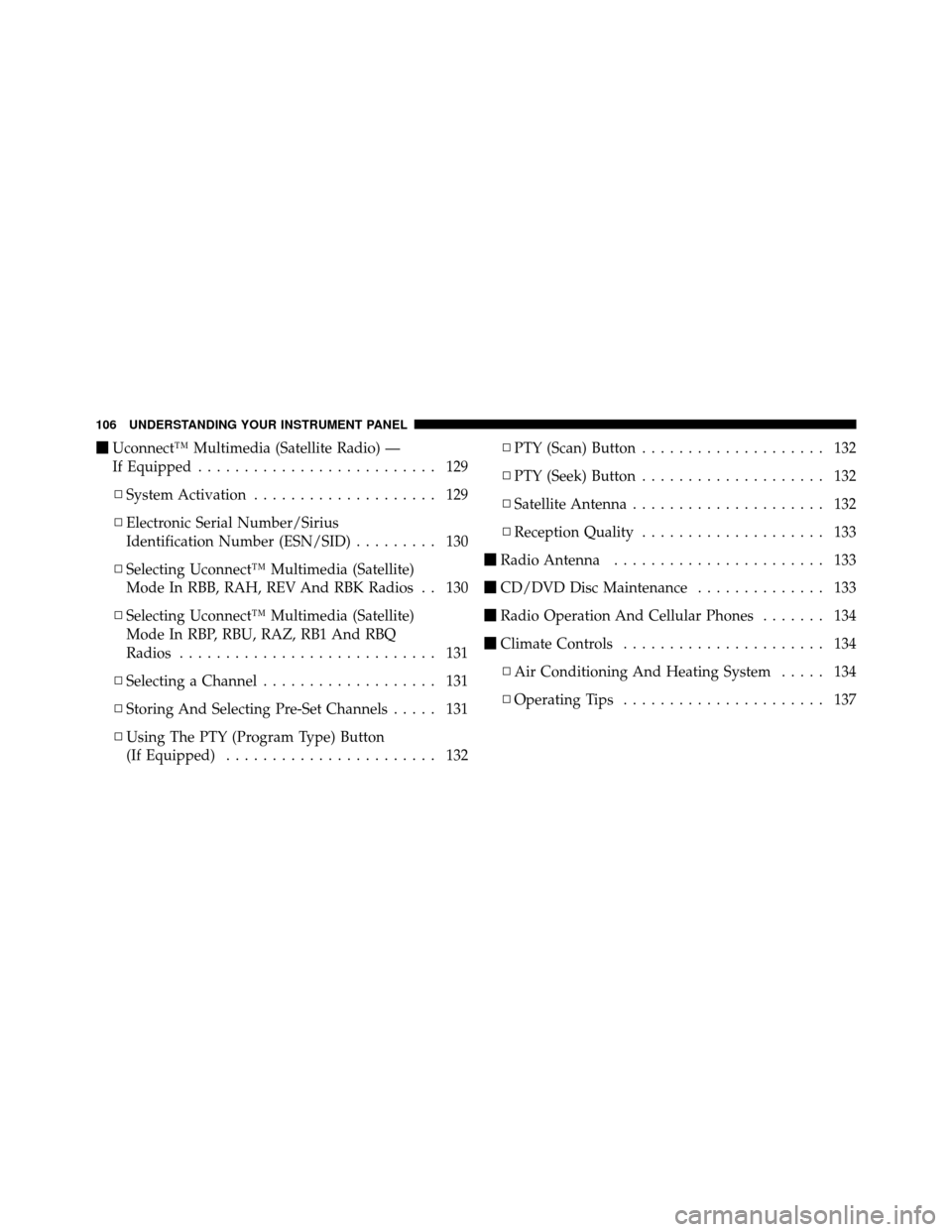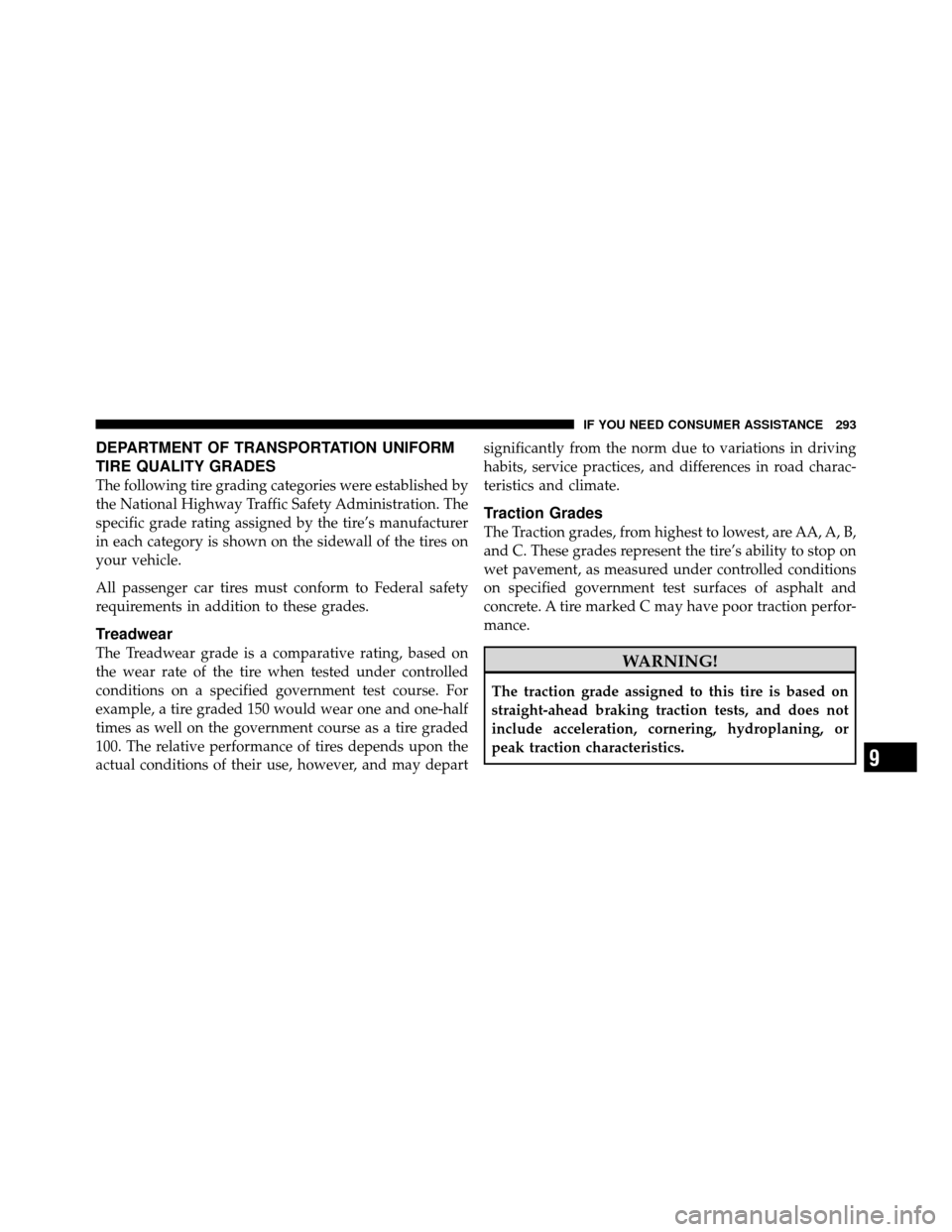Page 34 of 315

second. The parking lights and turn signal lights will
flash three times to acknowledge the signal.
NOTE:Pressing the UNLOCK button on the RKE
transmitter will also allow liftgate access.
Once unlocked, the liftgate can be opened or closed. To
open the liftgate, press the LIFTGATE RELEASE switch
located in the exterior liftgate handle and pull the liftgate
open with one fluid motion.
NOTE: The liftgate release switch will be ignored under
the following conditions:
•When the ignition is in ON/RUN and the parking
brake is not set.
•When vehicle speed is not 0 mph (0 km/h).
•When all doors are locked (except for RKE transmitter
liftgate access). Refer to “Entering the Liftgate with the
System Armed — Coupe” under “Security Alarm
System” for additional information. The word “DECK” will flash in the odometer when the
liftgate is open. With the key in the ignition switch, this
display will turn off approximately 40 seconds after
switching OFF the ignition, or if the Power Accessory
Delay feature is active, it will turn off approximately
40 seconds after the delay feature times out.
WARNING!
•Driving with the liftgate open can allow poison-
ous exhaust gases into your vehicle. You and your
passengers could be injured by these fumes. Keep
the liftgate closed when you are operating the
vehicle.
•If you are required to drive with the liftgate open,
make sure that all windows are closed, and the
climate control blower switch is set at high speed.
DO NOT use the recirculation mode.
30 THINGS TO KNOW BEFORE STARTING YOUR VEHICLE
Page 69 of 315

If you are required to drive with the trunk/liftgate open,
make sure that all windows are closed and the climate
control BLOWER switch is set at high speed. DO NOT
use the recirculation mode.
The best protection against carbon monoxide entry into
the vehicle body is a properly maintained engine exhaust
system.
Whenever a change is noticed in the sound of the exhaust
system, when exhaust fumes can be detected inside the
vehicle, or when the underside or rear of the vehicle is
damaged, have a competent mechanic inspect the com-
plete exhaust system and adjacent body areas for broken,
damaged, deteriorated, or mispositioned parts. Open
seams or loose connections could permit exhaust fumes
to seep into the passenger compartment. In addition,
inspect the exhaust system each time the vehicle is raised
for lubrication or oil change. Replace as required.Safety Checks You Should Make Inside the
Vehicle
Seat Belts
Inspect the belt system periodically, checking for cuts,
frays, and loose parts. Damaged parts must be replaced
immediately. Do not disassemble or modify the system.
Front seat belt assemblies must be replaced after a
collision. Rear seat belt assemblies must be replaced after
a collision if they have been damaged (i.e., bent retractor,
torn webbing, etc.). If there is any question regarding belt
or retractor condition, replace the belt.
Airbag Warning Light
The light should come on and remain on for four to eight
seconds as a bulb check when the ignition switch is first
turned ON. If the light is not lit during starting, see your
authorized dealer. If the light stays on, flickers, or comes
on while driving, have the system checked by an autho-
rized dealer.
2
THINGS TO KNOW BEFORE STARTING YOUR VEHICLE 65
Page 108 of 315

REAR WINDOW FEATURES
Rear Window Defroster
The rear window defroster button is located on the
climate control panel. Press this button to turn on
the rear window defroster and the heated outside mirrors
(if equipped). An indicator in the button will illuminate
when the rear window defroster is on. The rear window
defroster automatically turns off after approximately
10 minutes. For an additional five minutes of operation,
press the button a second time.
NOTE: To prevent excessive battery drain, use the rear
window defroster only when the engine is operating.
CAUTION!
Failure to follow these cautions can cause damage to
the heating elements:
•Use care when washing the inside of the rear
window. Do not use abrasive window cleaners on
the interior surface of the window. Use a soft cloth
and a mild washing solution, wiping parallel to
the heating elements. Labels can be peeled off
after soaking with warm water.
•Do not use scrapers, sharp instruments, or abra-
sive window cleaners on the interior surface of the
window.
•Keep all objects a safe distance from the window.
104 UNDERSTANDING THE FEATURES OF YOUR VEHICLE
Page 110 of 315

�Uconnect™ Multimedia (Satellite Radio) —
If Equipped .......................... 129
▫ System Activation .................... 129
▫ Electronic Serial Number/Sirius
Identification Number (ESN/SID) ......... 130
▫ Selecting Uconnect™ Multimedia (Satellite)
Mode In RBB, RAH, REV And RBK Radios . . 130
▫ Selecting Uconnect™ Multimedia (Satellite)
Mode In RBP, RBU, RAZ, RB1 And RBQ
Radios ............................ 131
▫ Selecting a Channel ................... 131
▫ Storing And Selecting Pre-Set Channels ..... 131
▫ Using The PTY (Program Type) Button
(If Equipped) ....................... 132 ▫
PTY (Scan) Button .................... 132
▫ PTY (Seek) Button .................... 132
▫ Satellite Antenna ..................... 132
▫ Reception Quality .................... 133
� Radio Antenna ....................... 133
� CD/DVD Disc Maintenance .............. 133
� Radio Operation And Cellular Phones ....... 134
� Climate Controls ...................... 134
▫ Air Conditioning And Heating System ..... 134
▫ Operating Tips ...................... 137
106 UNDERSTANDING YOUR INSTRUMENT PANEL
Page 111 of 315
INSTRUMENT PANEL FEATURES
1 — Air Outlet7 — Speedometer/Odometer 13 — Climate Control
2 — Sound System Speaker 8 — Oil Pressure Gauge 14 — ENGINE START Button
3 — Main Message Center 9 — Passenger Airbag Off Light 15 — Voltage Gauge
4 — Fuel Gauge 10 — Passenger Airbag 16 — Engine Coolant Temperature Gauge
5 — Auxiliary Message Center 11 — Glove Compartment 17 — Engine Oil Temperature Gauge
6 — Tachometer 12 — Sound System Controls 18 — TRIP Button
4
UNDERSTANDING YOUR INSTRUMENT PANEL 107
Page 138 of 315
NOTE:If you experience difficulty in playing a particu-
lar disc, it may be damaged (i.e., scratched, reflective
coating removed, a hair, moisture or dew on the disc)
oversized, or have protection encoding. Try a known
good disc before considering disc player service.
RADIO OPERATION AND CELLULAR PHONES
Under certain conditions, the cellular phone being on in
your vehicle can cause erratic or noisy performance from
your radio. This condition may be lessened or eliminated
by relocating the cellular phone antenna. This condition
is not harmful to the radio. If your radio performance
does not satisfactorily “clear” by the repositioning of the
antenna, it is recommended that the radio volume be
turned down or off during cellular phone operation.
CLIMATE CONTROLS
The Air Conditioning and Heating System is designed to
make you comfortable in all types of weather.
Air Conditioning and Heating System
Air Conditioning And Heater Controls
134 UNDERSTANDING YOUR INSTRUMENT PANEL
Page 139 of 315
Blower Control
Use this control to regulate the
amount of air forced through the sys-
tem in any mode you select. Turn the
control clockwise to increase fan
speed. Turn the control to the O (Off)
position to shut off the fan and to
prevent any outside air from entering
the vehicle. This also turns off the A/C compressor.
NOTE: For vehicles equipped with Remote Start, the
climate controls will not function during Remote Start
operation if the blower control is left in the “O” (Off)
position.
Temperature Control
Use this control to regulate the tem-
perature of the air inside the passenger
compartment. The blue area of the
control indicates cooler temperatures
while the red area indicates warmer
temperatures.
Mode Control
Use this control to select the direction
of air flow.
NOTE: The dot between the mode control icons is a mix
position between the two modes.
4
UNDERSTANDING YOUR INSTRUMENT PANEL 135
Page 297 of 315

DEPARTMENT OF TRANSPORTATION UNIFORM
TIRE QUALITY GRADES
The following tire grading categories were established by
the National Highway Traffic Safety Administration. The
specific grade rating assigned by the tire’s manufacturer
in each category is shown on the sidewall of the tires on
your vehicle.
All passenger car tires must conform to Federal safety
requirements in addition to these grades.
Treadwear
The Treadwear grade is a comparative rating, based on
the wear rate of the tire when tested under controlled
conditions on a specified government test course. For
example, a tire graded 150 would wear one and one-half
times as well on the government course as a tire graded
100. The relative performance of tires depends upon the
actual conditions of their use, however, and may departsignificantly from the norm due to variations in driving
habits, service practices, and differences in road charac-
teristics and climate.
Traction Grades
The Traction grades, from highest to lowest, are AA, A, B,
and C. These grades represent the tire’s ability to stop on
wet pavement, as measured under controlled conditions
on specified government test surfaces of asphalt and
concrete. A tire marked C may have poor traction perfor-
mance.
WARNING!
The traction grade assigned to this tire is based on
straight-ahead braking traction tests, and does not
include acceleration, cornering, hydroplaning, or
peak traction characteristics.
9
IF YOU NEED CONSUMER ASSISTANCE 293